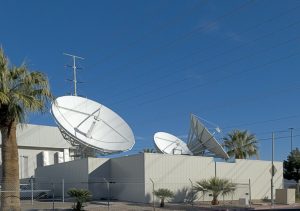 Communications can be a problem for fieldwork and in remote areas. Fixed or wireless services might not be available because there are no structures to support them. A VSAT satellite could be the best option in these cases.
Communications can be a problem for fieldwork and in remote areas. Fixed or wireless services might not be available because there are no structures to support them. A VSAT satellite could be the best option in these cases.
Here are quick facts about VSAT and its uses. These may help you decide if it is the right option for your needs.
Definition
VSAT stands for Very Small Aperture Terminal. It is “very small” because the antenna in a VSAT satellite dish is just four feet across. You could mount it on a roof or on the ground. VSAT is a land-based technology that sends data using a satellite signal.
The signal goes to the converter attached to the antenna. The block upconverter or BUC changes the signal from a lower frequency to a higher one, and then sends the signals to a computer or mobile device. If there are many users in a VSAT system, the data goes to a land-based hub.
Uses
VSAT satellites can handle data the same way as other communications technologies. It can handle audio as well as video. In fact, telephone services are faster with VSAT than a regular service. While the technology is ideal for remote areas, such as on an oil rig or a ship, you could use it anywhere.
You have to sign on for a service if you are a home user. If you need it for a company or organisation, you could lease or put up your own VSAT system. This is a big advantage if you want more control over communications.
You do not have to rely on a service provider. You could rent or buy the equipment and make your own private network. Many companies use VSAT for POS systems and other financial systems. It is also popular in law enforcement, military operations, and emergency services.
VSAT satellite is a great option for communications if other services are not available. It is also worth considering if you want more control over your communications system. The initial costs might be high, but it is worth it in many cases.
